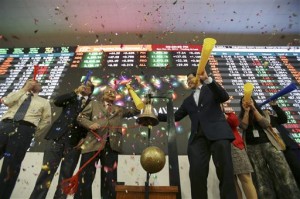
Confetti falls as Filipino traders ring the bell to close the last trading day of the year at the Philippine Stock Exchange in the financial district of Makati on Monday, Dec. 29, 2014. The analyst who predicted the impact of the 1997 East Asian financial crisis on the Philippines has warned that the current bull run in the local stock market was nearing its end—but not before giving investors one final chance to make significant profits. AP PHOTO/AARON FAVILA
MANILA, Philippines–The analyst who predicted the impact of the 1997 East Asian financial crisis on the Philippines has warned that the current bull run in the local stock market was nearing its end—but not before giving investors one final chance to make significant profits.
BPI Trade CEO Michalangelo Oyson described the current situation as the “last call of the happy hour” where Philippine equities are likely to make one major push to record highs, before embarking on a major price correction in 2016.
“I believe the fair value of the stock market [index] is 7,800,” he told clients of the Ayala-controlled financial institution in a briefing late last week. “We can reach 8,400 before we come back down.”
As of last Friday, the Philippine Stock Exchange index (PSEi) has risen to 7,728.18 points—compared to 6,011.14 exactly a year ago—on the back of a surge in liquidity from foreign funds seeking better returns in emerging markets.
The almost 30-percent year-on-year return has made the PSEi one of the best-performing stock markets in the world for 2014.
An analyst for the defunct Deutsche Morgan Grenfell securities house in 1996, Oyson predicted a sharp downturn for Philippine banks, warning that their growing exposure to the then booming real estate market would precipitate a liquidity crunch once fund flows reversed.
In the wake of that report, ranking officials of the Bangko Sentral ng Pilipinas scrambled to debunk his findings, pronouncing the local banking scene healthy and the property market robust.
Seven months later, Oyson was proven right when the financial crisis erupted in Thailand and rolled across the region.
This time around, however, Oyson said local stocks—though pricey—might still move upward due to the expected inflow of abundant liquidity from overseas, aided by continuing loose monetary policy from central banks in Europe, Japan and the United States.
“We ended 2014 with [an average] price-earnings ratio of 20 times for the PSEi,” he pointed out, referring to the metric that measures the number of years it would take for for a company’s earnings to catch up with its stock price. “At one point, we were at a peak of 22 times, while Indonesia was at 30 times. By any measure, we’re no longer cheap.”